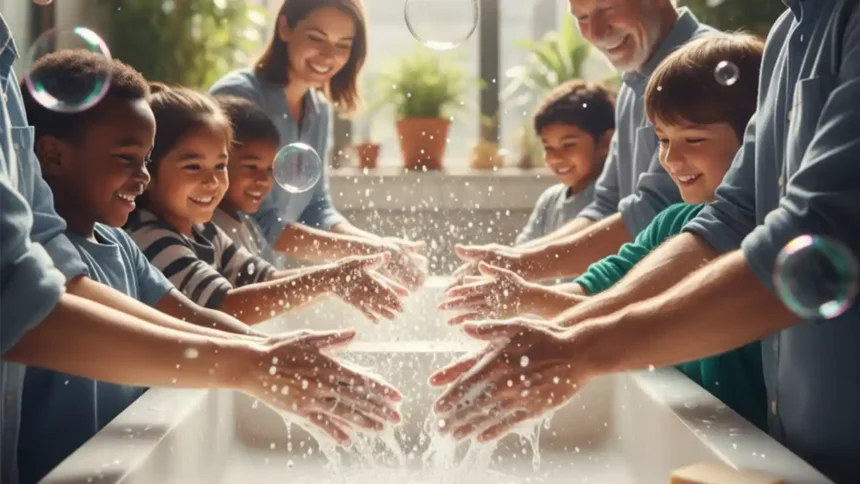Clean Hands, Healthy Futures: A Quick Guide to World Hand Wash Day
I have seen how small habits can make a huge difference in public health. Among these habits, handwashing stands as one of the simplest yet most powerful actions that can save millions of lives every year. This is the message behind World Hand Wash Day, celebrated globally to remind us that clean hands are not just about hygiene — they are about health, dignity, and safety.
Why Handwashing Matters: The Science and Facts
Handwashing may seem like a small act, but it prevents many infections and diseases that affect millions of people every day. Proper handwashing removes germs that can cause illnesses such as diarrhea, flu, COVID-19, and other infections.
Preventing Diseases Through Clean Hands
- Proper hand hygiene can prevent almost half of all infections acquired in hospitals and clinics.
- In communities, washing hands regularly can reduce diarrheal diseases by around 30% and respiratory infections by 20–25%.
- Many people still do not have access to clean water and soap at home, which increases their risk of illness and death.
- If everyone practiced proper handwashing, millions of lives could be saved, especially among children under five.
The Problem: We Still Don’t Wash Enough
Even though most people know handwashing is important, many forget to do it regularly or do not do it properly. In many countries, people admit that they sometimes skip washing their hands after using the toilet or before eating. Some people think it takes too much time, while others simply forget.
In hospitals and clinics, even trained staff sometimes skip proper hand hygiene steps. This puts both patients and workers at risk. This shows that knowledge is not enough — we need constant reminders, access to facilities, and motivation to make it a regular habit.
World Hand Wash Day: What, When, and Why
What is World Hand Wash Day?
World Hand Wash Day, also called Global Handwashing Day, is celebrated every year to raise awareness about the importance of washing hands with soap. The day reminds us that clean hands save lives and that every person should make handwashing a daily habit.
The event is organized by health organizations, governments, schools, and communities around the world. It promotes creative and practical ways to encourage people to wash their hands regularly and correctly.
When is it Celebrated?
World Hand Wash Day, also called Global Handwashing Day, is celebrated every year on October 15.
It is a global movement that brings together people from all countries to promote hygiene and handwashing practices.
Why it is Celebrated
This day is celebrated to:
- Remind everyone about the importance of washing hands.
- Motivate schools, communities, and governments to provide handwashing facilities.
- Encourage innovation to make handwashing easier and more affordable.
- Promote hygiene education, especially among children.
- Support global goals like clean water and sanitation for all.
How to Wash Hands Properly
Knowing how to wash hands the right way is just as important as doing it often. Here are the five steps everyone should follow:
- Wet your hands with clean, running water.
- Apply soap and rub your hands together to make a lather.
- Scrub for at least 20 seconds, making sure to clean the backs of hands, between fingers, and under nails.
- Rinse your hands well under running water.
- Dry your hands using a clean towel or let them air dry.
If soap and water are not available, use an alcohol-based sanitizer that contains at least 60% alcohol. However, sanitizers are not as effective when your hands are visibly dirty or greasy — in that case, soap and water are best.
When to Wash Hands
Washing your hands at the right times helps prevent the spread of germs. The most important moments include:
- After using the toilet: Feces are a major source of germs that cause diarrhea.
- After cleaning a child who has used the toilet.
- Before preparing food: This prevents you from transferring germs from your hands onto the food.
- Before eating or feeding a child: This stops germs from entering your body directly.
- After coughing, sneezing, or blowing your nose: This removes respiratory droplets that can spread viruses.
- After touching animals, their food, or their waste.
- Before and after caring for someone who is sick.
- In healthcare settings, professionals follow the WHO’s “5 Moments for Hand Hygiene,” which are even more specific to protect patients.
Remember — washing at critical moments matters most. It’s not just how often you wash, but when you do it that protects you and others.
Common Barriers to Handwashing
Despite its importance, billions of people still don’t wash their hands properly due to several reasons:
Lack of Facilities
In many regions, people do not have easy access to clean water or soap. Many schools, homes, and workplaces lack handwashing stations. Without these facilities, even those who want to wash cannot do it regularly.
Behavioural Challenges
Some people think washing hands every time is unnecessary or time-consuming. Others forget, especially when they are in a hurry or outside their homes. Handwashing may also not be a strong social norm in some communities, which reduces motivation.
Economic Barriers
Soap and water may seem affordable, but in poor communities, even small costs can be a burden. In such cases, low-cost innovations and community support are essential.
Cultural Beliefs
In some places, people may have traditional beliefs that discourage handwashing or make it seem less important. Health education must be sensitive to these beliefs and introduce hygiene in a respectful way.
Policy and Support Gaps
In many countries, hygiene promotion is not a strong part of public health policies. Without proper funding, infrastructure, and leadership, large-scale behavior change is difficult to achieve.
Global Handwashing Day Activities
Every year, Global Handwashing Day is celebrated through fun and educational activities around the world. Here are some common ideas and examples:
School Programs
- Organize handwashing demonstrations and group activities.
- Hold drawing, slogan, or poster competitions about clean hands.
- Teach children songs or rhymes about hygiene.
- Make a “handwashing pledge” wall where students write their promises to wash hands daily.
Community Events
- Set up handwashing stalls at markets and public places.
- Conduct demonstrations on proper technique.
- Distribute free soap and leaflets.
- Invite local health workers to give talks and answer questions.
Media and Social Campaigns
- Use hashtags like #GlobalHandwashingDay to share awareness online.
- Post videos and pictures of people washing their hands.
- Share success stories of communities improving hygiene.
Health Facility Programs
- Hospitals and clinics conduct staff training on hand hygiene.
- Display posters reminding health workers to clean their hands before and after patient care.
- Educate visitors and patients on handwashing importance.
Workplace Activities
- Offices can organize short awareness sessions.
- Place sanitizers at every desk or door.
- Encourage employees to maintain hygiene and spread the message.
Creative Ideas
- Make short awareness films and share them on local TV or social media.
- Organize art contests, puppet shows, or street plays to attract attention.
- Build portable handwashing stations for outdoor areas.
These activities create excitement and help build long-term habits that last beyond the celebration day.
Innovations in Hand Hygiene
Innovation plays a big role in promoting hygiene, especially where resources are limited. Some modern solutions include:
- Low-water handwashing devices that use very little water but provide proper cleaning.
- Automatic taps that prevent contamination and save water.
- Affordable soaps made from local materials.
- Wearable devices and sensors that teach correct handwashing movement to healthcare workers.
- Awareness apps that send reminders for hand hygiene at regular times.
Such innovations make it easier for people to keep their hands clean and reduce the spread of diseases.
What You Can Do Personally
You don’t need to be a health expert to make a difference. Every person can help promote hand hygiene:
- Be a role model. Always wash your hands properly and encourage others to do the same.
- Teach children. Show them how and when to wash hands.
- Set up facilities. Make sure soap and water are available in your home, school, or workplace.
- Share awareness. Talk about handwashing in your family, on social media, and with friends.
- Support hygiene programs. Volunteer or donate to organizations that build sanitation facilities.
Even small actions — like reminding a friend to wash hands — can help protect entire communities.
Conclusion: Clean Hands, Healthy Lives
World Hand Wash Day is more than a global event — it is a reminder of our shared responsibility. Every clean hand contributes to a healthier family, community, and planet. Handwashing protects us from infections, builds good hygiene habits in children, and supports public health goals.
This October 15, let’s not just celebrate — let’s commit. Let us make every day a handwashing day. Because the power to protect yourself and others is right in your hands — literally.
FAQs
Q1: Why should we wash our hands for 20 seconds?
Washing for 20 seconds ensures that all germs are removed from every part of your hand — including the back, fingertips, and under nails. It allows the soap to work effectively.
Q2: Can sanitizer replace handwashing?
Sanitizer is useful when soap and water are not available, but it cannot remove dirt, grease, or some types of germs. Washing with soap and water is always the best option.
Q3: How much water is needed for handwashing?
You don’t need a lot — just enough to wet and rinse your hands. Using small water-saving devices can help you wash properly without wasting water.
Q4: What if soap is not available?
If soap is not available, using ash or sand can help in emergencies, but it is less effective. Communities should work to make soap accessible for everyone.
Q5: How can schools encourage handwashing?
Schools can create fun activities, build handwashing stations, teach hygiene lessons, and encourage children to remind each other regularly.









